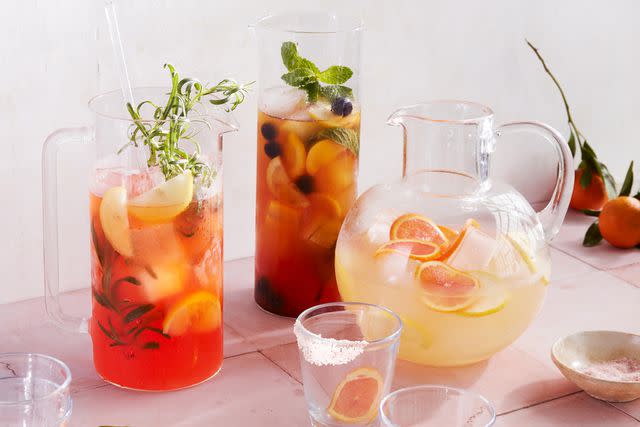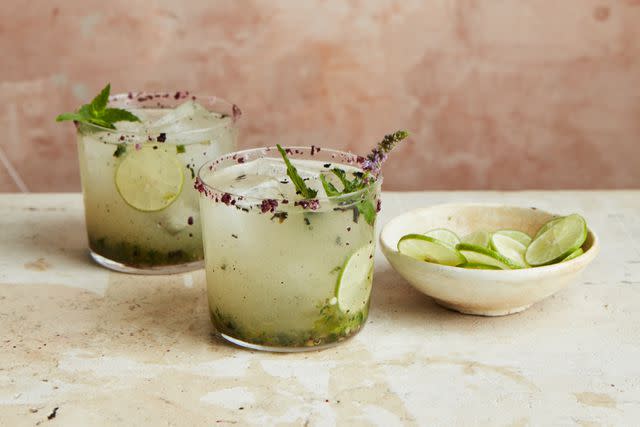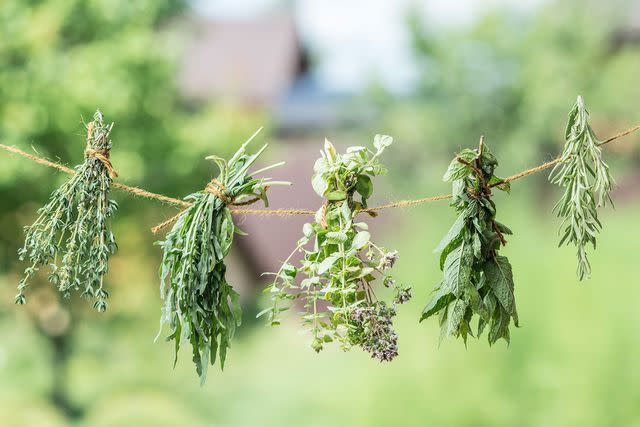How to Plant a Cocktail Garden Full of Flavorful Garnishes for All of Your Drinks
There's no better way to garnish your cocktails than with fresh herbs and fruit grown right at home.
:max_bytes(150000):strip_icc():format(jpeg)/ms-cocktail-garden-mint-getty-ee85968f522141a09f99f7205ec863de.jpg)
bhofack2 / Getty
Love making mojitos, margaritas and gimlets at home? Creating your own cocktail garden is a fun way to have fresh ingredients all season long—and elevate your delicious drink creations.
Growing your own herbs for cocktails is a fun activity that anyone can do. Whether you enjoy having gatherings at your home or like making a special drink when the moment calls for it, growing a cocktail garden provides the freshest herbs available within easy reach.
"One of the biggest advantages is having immediate access to the freshest ingredients, picked when the flavors are at their peak," says Diane Keesee, an instructor at Mt. Cuba Center. Herbs are simple to grow and don't require much space. Do you only have a tiny balcony, porch, or a windowsill? You can grow a cocktail garden. "Herbs used in some of our favorite drinks—with or without alcohol—can grow in almost any small, sunny spot; they don't need a great amount of soil depth and grow faster than many other plants," says Perla Sofía Curbelo-Santiago, founder of Agrochic and author of ¡Verdura! Living a Garden Life.
Ahead, see which plants our experts recommend and learn how to grow a cocktail garden of your very own.
Meet Our Expert
Diane Keesee, instructor at Mt. Cuba Center, a botanical garden in Hockessin, Delaware
Perla Sofía Curbelo-Santiago, founder of Agrochic, a gardening lifestyle platform, and author of ¡Verdura! Living a Garden Life
Sue Betz, author of Herbal Houseplants
Related: How to Grow a Tea Garden That Will Yield the Perfect Blend
How to Plan a Cocktail Garden

Before you start planting your garden, you'll need to consider how much space you have, how much sun shines in the area, and whether you'll plant directly into the ground, in a raised bed, or in containers. "The ideal spot should be sunny, visible to you, and easy to access the herbs," says Curbelo-Santiago. "If you're growing more than one herb in the same pot, which is great for maximizing your space, make sure the plants share the same growing conditions—light, water, soil." For example, she says, rosemary and thyme grow well together. And if you're growing more than herbs, remember that fruits will generally take more space than herbs, says Keesee.
Many herbs thrive in the sun. Don't assume that the care needed for one herb is what all herbs need to thrive. "Pay attention to the growing needs of each kind of plant; herbs like basil will do better with morning sun and some shade for the heat of the day," says Keesee.
If you're not sure what to grow or how to decide, start with the herbs you know you already enjoy in your drinks and go from there, suggests Curbelo-Santiago. Allow yourself to try new herbs and see how they grow. And don't be afraid to experiment with new flavor combinations.
Best Plants for a Cocktail Garden

Try your hand at growing these herbs and fruit to get started with your cocktail garden.
Basil
Basil is a fragrant herb that is a key ingredient for pesto as well as Caprese salads. This heat-loving herb also makes a wonderful simple syrup for cocktails. "[These] plants require at least four hours of direct sun per day and should be planted in rich, loamy, and well-drained soil with a neutral pH value of around 7," says Sue Betz, author of Herbal Houseplants. Basil needs warm weather and a sunny spot to thrive, with Betz noting that basil plants don't react well to cool, damp soil and weather.
Grow several varieties of basil to add different flavor profiles to your drinks. "Thai basil has a sweet, intense, spicy flavor with notes of clove and anise," says Betz. "Compared to other basil varieties, its robust flavor in infusions and simple syrups holds up well in herbal cocktails." She says you can use the fresh leaves and flowers for botanical mixers for fun summer beverages, along with your cocktails.
Ready to use basil to make a drink? "Harvesting can begin anytime there is sufficient foliage on the plant to tolerate cutting," she says.
Related: How to Grow and Care for Basil Plants, a Summer Annual You Need in Your Culinary Garden
Rosemary
Another sun-loving herb, rosemary is easy to grow. Plant directly in the ground or grow in containers in well-draining soil. Place in an area that receives sunlight for most of the day, around six hours. Curbelo-Santiago suggests using rosemary for cocktails with rum, tequila, or whiskey and using the sprigs and flowers as a garnish.
Related: Everything You Need to Know About Rosemary
Thyme
Thyme, a hardy herb that loves basking in the sun, grows well in most climates. Experiment with thyme varieties by planting lemon thyme—a fragrant herb full of citrusy notes that will add a lemony touch to your drinks. "Lemon thyme is a fun herb to grow in your themed garden," says Curbelo-Santiago. She says to use thyme for any gin or vodka-based cocktails.
Related: 10 Herbs You Should Stop Buying and Start Growing
Mint
If you love making and drinking juleps and mojitos, you'll want to plant plenty of mint. "Native mints, like mountain mint (Pycnanthemum), are wonderful to add brightness to cocktails or non-alcoholic beverages like iced tea," says Keesee. Grow mint in well-draining soil in a container as it spreads by rhizome and will easily overtake other plants it shares space with. Mint is adaptable and, once it gets growing, is typically low-maintenance. Mint likes moist soil but never sopping wet. "Mountain mint can be grown in sun to part sun and does best in well-drained soils," says Keesee.
Related: How to Grow and Care for Mint in Your Garden or on Your Windowsill
Scented Geranium
Scented geraniums are known for their aromatic leaves and are often referred to as fragrant leaf geranium. "The flowers are edible, and the leaves release tremendous flavor into simple syrup," says Betz. "They are fabulously muddled into gin or vodka and lend a floral essence to martinis." Have a favorite scent? "You can grow scented geraniums that smell like roses, nutmeg, peppermint, orange, lemon, and lime," she says. She recommends P. Rober's Lemon Rose for a cocktail garden.
Grow scented geraniums in a sunny spot in well-drained soil, says Betz. If you lack garden space, they do well in containers. They can also be grown indoors as long as they receive at least four hours of sunlight per day, she adds.
Related: A Visual Guide to Edible Flowers—and How to Use Them
Strawberries
Are you a fan of daiquiris, margaritas, or strawberry mojitos? Plant strawberries in your cocktail garden. "Strawberries are so versatile because they have a delicate flavor that doesn't overpower other ingredients," says Keesee. "They also pair well with other flavors like citrus and mint and can be muddled to make those delicious strawberry margaritas or even strawberry/mint juleps."
Plant strawberries in an area that receives sun for most of the day—aim for a minimum of six hours—and in well-draining soil. You can grow them directly in the ground or in containers. "I like to grow strawberries in a raised bed mulched with straw to keep them out of the soil and away from slugs," says Keesee.
Have a bountiful harvest and can't eat them all? Use them to make a shrub when they're at their peak. "A shrub [is] an easy mixture of equal parts of sugar, fruit, and vinegar that will keep for months in your refrigerator," says Keesee. And if you're in the mood for a non-alcoholic beverage, make a spritzer. "A spoonful of shrub added to club soda makes a very refreshing spritzer," she says.
Related: How to Grow Sweet Strawberries That Will Produce Fruit Every Year
How to Harvest Your Cocktail Garden

Lennart Weibull
The fun part about growing herbs is you'll reap the rewards within a couple of months. When you're ready to make a simple syrup or add herbs to your cocktail, there are some simple rules for harvesting. “Harvest what you need," says Curbelo-Santiago.
The best time to snip your herbs is in the morning. "Harvest herbs in the morning after the dew has dried and before the sun gets too hot," says Betz. "Pick healthy growth and discard damaged flowers and leaves." A rule of thumb is to only harvest what you need and plan to use.
How to Dry and Store Herbs

ValentynVolkov / Getty Images
If you have a bounty of herbs, you can harvest and dry them for another time. To dry herbs, you can either hang them in bundles to air-dry or spread them on a screen. Just make sure there is good air circulation.
Drying on a screen: "Strip the fresh leaves or flowers from the plant stems and spread them in a thin layer on screens," says Betz. "You can use a house window screen lined with cheesecloth or paper towels—place screens in a well-ventilated area to dry."
Drying in a bundle: If you have less space, you can gather herbs and hang them to dry. "Tie large leafy-stemmed herbs into loose bundles and hang them in a room or closet with good air circulation," says Betz. Drying time can vary–anywhere from two days to several weeks, she adds.
Once they're dry, it's time to store them properly to ensure longevity and freshness. "Store dried herbs in clean glass jars away from the heat and light to preserve their flavors and fragrances," says Betz.
Related: 10 Ways to Upgrade Your Summer Cocktails
Using Ingredients From Your Cocktail Garden

There are an array of cocktails you can make by harvesting herbs or muddling strawberries. Consider making these drinks inspired by your cocktail garden.
Read the original article on Martha Stewart.

